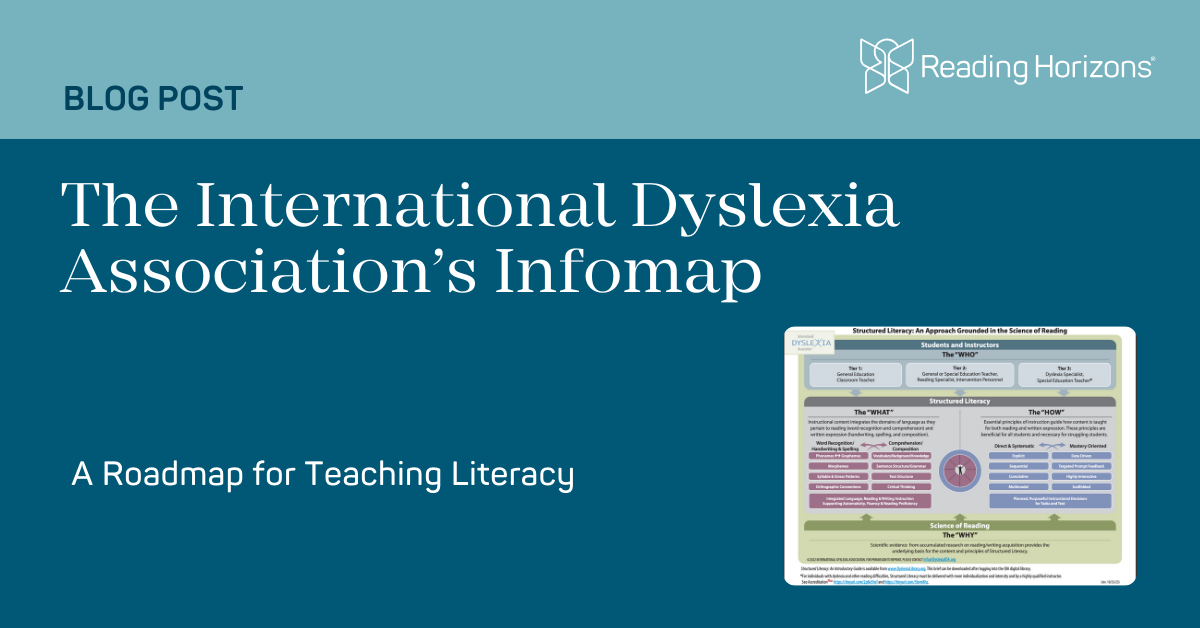Understanding the Framework That Guides Effective Structured Literacy Instruction
Introduction: Why Educators Need a Roadmap for Literacy Instruction
Teaching literacy is a complex and multifaceted process. With decades of research supporting evidence-based approaches, educators must navigate various components to provide effective instruction. However, knowing where to start—and how to integrate different elements—can be overwhelming.
That’s where the Structured Literacy Infomap comes in. This tool, aligned with the International Dyslexia Association’s (IDA) framework, serves as a roadmap for educators—offering a clear, visual representation of Structured Literacy principles and practices.
In this foundational piece, we’ll break down the key takeaways from our podcast episode, “The Infomap: A Roadmap for Teaching Literacy.“ You’ll learn what the Infomap is, why it matters, and how it can support both educators and students.
Want your own copy of the Infomap? You can download a free copy from the IDA website here.

What Is the Structured Literacy Infomap?
The Structured Literacy Infomap is designed to synthesize and summarize essential elements of literacy instruction, aligning them with the science of reading.
The Infomap provides a visual representation of Structured Literacy principles and practices. It helps educators align on a framework that integrates reading, writing, and comprehension.” — Stacy Hurst
The Infomap emphasizes that Structured Literacy is not a program but an approach—one that requires professional learning, ongoing support, and high-quality instruction.
At its core, the Infomap presents a framework that includes:
- Phonemic Awareness
- Phonics and Word Recognition
- Syllables and Stress Patterns
- Morphology (Morphemes and Word Parts)
- Orthographic Conventions
Each component plays a critical role in literacy development and must be taught systematically and explicitly.
Bridging the Gap: How the Infomap Enhances Professional Development
One of the biggest challenges in literacy education is ensuring that teacher knowledge translates into effective practice. Research has consistently shown that teachers need both training and ongoing support to successfully implement Structured Literacy.
The key isn’t just professional development—it’s also the follow-up and support teachers need. Too often, educators are given training but lack the resources or coaching to fully implement what they’ve learned.” — Lindsay Kemeny
The Infomap helps bridge this gap by providing a structured approach that educators can reference throughout their teaching journey. It ensures that literacy instruction is:
✅ Comprehensive – Covers all aspects of reading and writing
✅ Explicit and Systematic – Provides clear, direct instruction
✅ Integrated – Connects reading, writing, spelling, and comprehension
Key Components of the Infomap: Breaking It Down
Phonemic Awareness: The Foundation of Literacy
Phonemic awareness—the ability to recognize and manipulate individual sounds in spoken words—is one of the most critical skills for early literacy development. Research indicates that strong phonemic awareness skills directly support reading fluency and spelling.
For example, students who struggle with blending sounds often have difficulty decoding words. In Structured Literacy, educators use explicit instruction and practice to help students master this skill.
“Blending and segmentation at the phoneme level are the most important phonemic awareness skills since they lead directly to decoding and spelling.” — Stacy Hurst
Phonics and Word Recognition: Moving Beyond Phonemes
Phonemic awareness is just the beginning. Phonics instruction teaches students how phonemes correspond to graphemes—a crucial step in decoding.
Educators must ensure phonics instruction is:
- Explicit – Directly teaching letter-sound relationships
- Systematic – Following a structured sequence
- Cumulative – Building on previously taught skills
Misconceptions still exist about Structured Literacy. Some believe it’s just phonics, but the Infomap highlights its comprehensive nature, covering all elements of reading and writing.
Structured Literacy isn’t just phonics. The Infomap shows that comprehension, spelling, and composition are equally essential.” — Lindsay Kemeny
Syllables, Stress Patterns, and Morphology: Strengthening Word Knowledge
As students progress, they need strategies for reading longer words. The Infomap highlights two essential skills for this:
- Syllable division rules – Understanding how to break words into manageable parts
- Stress patterns – Recognizing which parts of words are emphasized in speech
Beyond syllables, morphology plays a huge role in vocabulary growth. Morphemes—the smallest units of meaning—help students decode and comprehend more complex words.
Words with more than one base element account for over half of the vocabulary students encounter after fourth grade. Teaching morphology is crucial for building strong readers.” — Donell Pons
Orthographic Conventions: Bringing Order to English Spelling
English spelling can seem chaotic, but orthographic conventions provide structure and predictability. The Infomap emphasizes the importance of teaching spelling patterns systematically.
For example:
- Silent E rule – Explaining why hope has an E but hop doesn’t
- Doubling rule – Why running has two Ns but hoping only has one
- Vowel-consonant patterns – Why magic has a Soft G sound but magnet does not
Educators should teach these conventions explicitly rather than expecting students to “pick them up” through exposure.
Bringing It All Together: How Educators Can Use the Infomap
So, how can teachers apply the Infomap in their classrooms?
✅ Use it as a reference tool – Align your instruction with its key principles
✅ Guide professional development – Ensure all teachers receive proper training
✅ Integrate all components – Avoid teaching skills in isolation
✅ Support students across all levels – From beginning readers to older students who need intervention
The Structured Literacy Infomap is a roadmap—one that helps educators navigate the complexities of reading instruction with confidence.
Download the Infomap for Free
The best part? You can download a free copy of the Structured Literacy Infomap from the IDA website here. Having this visual framework at your fingertips can help reinforce key literacy concepts and ensure you’re aligning your instruction with best practices.
Conclusion: A Clear Path Forward
Teaching literacy is a journey—one that requires structured, intentional instruction. The Structured Literacy Infomap serves as a guiding framework, ensuring that educators stay aligned with the science of reading.
By using this roadmap, teachers can support all learners—from early readers to older students who need intervention—building the foundation for lifelong literacy success.
Would you like to learn more? Listen to the full podcast episode, The Infomap: A Roadmap for Teaching Literacy, Part 1, for deeper insights! And stay tuned for Part 2, coming soon.

